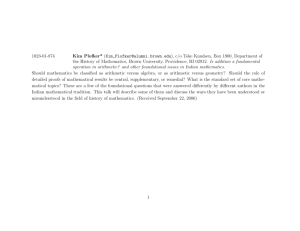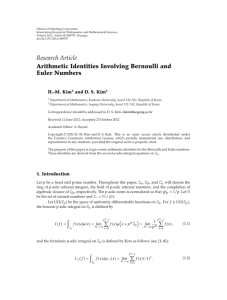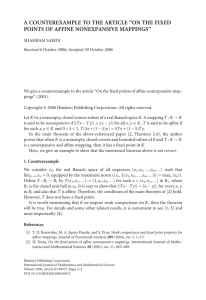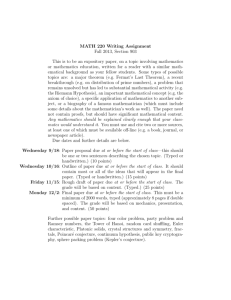Document 10455072
advertisement
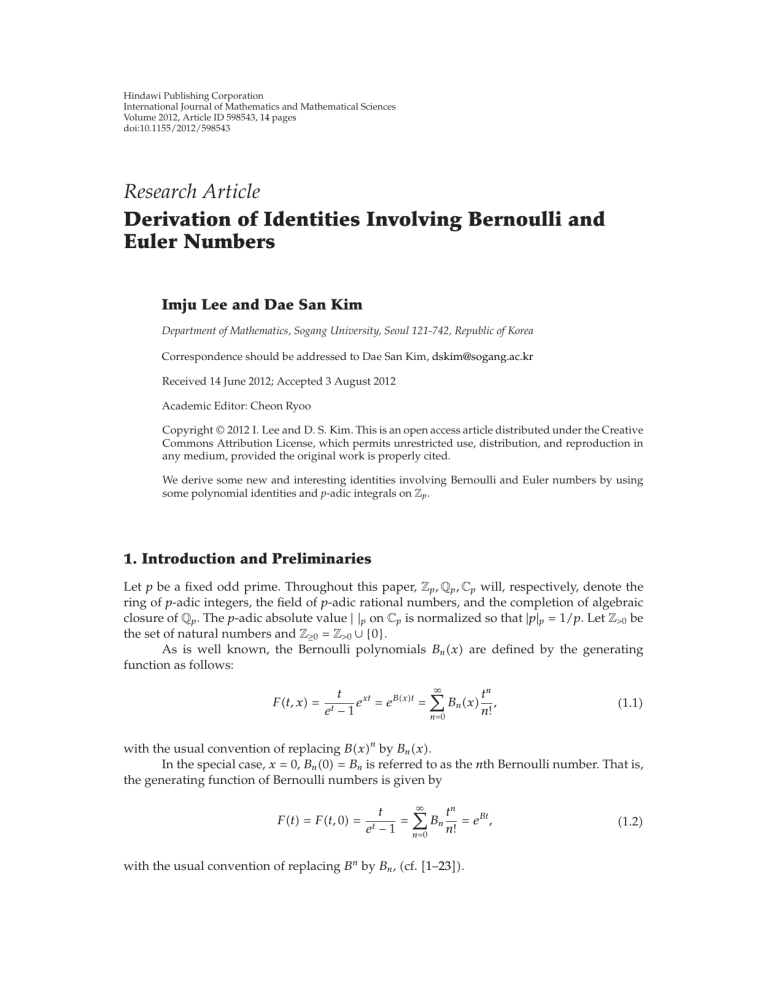
Hindawi Publishing Corporation
International Journal of Mathematics and Mathematical Sciences
Volume 2012, Article ID 598543, 14 pages
doi:10.1155/2012/598543
Research Article
Derivation of Identities Involving Bernoulli and
Euler Numbers
Imju Lee and Dae San Kim
Department of Mathematics, Sogang University, Seoul 121-742, Republic of Korea
Correspondence should be addressed to Dae San Kim, dskim@sogang.ac.kr
Received 14 June 2012; Accepted 3 August 2012
Academic Editor: Cheon Ryoo
Copyright q 2012 I. Lee and D. S. Kim. This is an open access article distributed under the Creative
Commons Attribution License, which permits unrestricted use, distribution, and reproduction in
any medium, provided the original work is properly cited.
We derive some new and interesting identities involving Bernoulli and Euler numbers by using
some polynomial identities and p-adic integrals on Zp .
1. Introduction and Preliminaries
Let p be a fixed odd prime. Throughout this paper, Zp , Qp , Cp will, respectively, denote the
ring of p-adic integers, the field of p-adic rational numbers, and the completion of algebraic
closure of Qp . The p-adic absolute value | |p on Cp is normalized so that |p|p 1/p. Let Z>0 be
the set of natural numbers and Z≥0 Z>0 ∪ {0}.
As is well known, the Bernoulli polynomials Bn x are defined by the generating
function as follows:
Ft, x et
∞
tn
t
ext eBxt Bn x ,
n!
−1
n0
1.1
with the usual convention of replacing Bxn by Bn x.
In the special case, x 0, Bn 0 Bn is referred to as the nth Bernoulli number. That is,
the generating function of Bernoulli numbers is given by
Ft Ft, 0 ∞
tn
t
eBt ,
B
n
et − 1 n0 n!
with the usual convention of replacing Bn by Bn , cf. 1–23.
1.2
2
International Journal of Mathematics and Mathematical Sciences
From 1.2, we see that the recurrence formula for the Bernoulli numbers is
B 1n − Bn δ1,n ,
for n ∈ Z≥0 ,
1.3
where δk,n is the Kronecker symbol.
By 1.1 and 1.2, we easily get the following:
Bn x B xn n n n
n
Bl xn−l Bn−l xl ,
l
l
l0
l0
for n ∈ Z≥0 .
1.4
Let UDZp be the space of uniformly differentiable Cp -valued functions on Zp . For f ∈
UDZp , the bosonic p-adic integral on Zp is defined by
I f p −1
1 fx,
N → ∞ pN
x0
N
Zp
fxdμx lim
1.5
I f1 I f f 0,
1.6
cf. 12. Then it is easy to see that
where f1 x fx 1 and f 0 dfx/dx|x0 .
By 1.6, we have the following:
Zp
exyt dμ y ∞
tn
t
xt
e
Bn x ,
t
n!
e −1
n0
1.7
cf. 12–14. From 1.7, we can derive the Witt’s formula for the nth Bernoulli polynomial
as follows:
n x y dμ y Bn x, for n ∈ Z≥0 .
1.8
Zp
By 1.1, we have the following:
Bn 1 − x −1n Bn x,
for n ∈ Z≥0 .
1.9
Thus, from 1.3, 1.4, and 1.9, we have the following:
Bn 1 Bn δ1,n −1n Bn ,
for n ∈ Z≥0 .
1.10
By 1.4, we have the following:
n n
Bn x y Bk xyn−k ,
k
k0
for n ∈ Z≥0 .
1.11
International Journal of Mathematics and Mathematical Sciences
3
Especially, for x 1 and y 1,
Bn 2 n n
k0
k
Bk 1 n n
Bk δ1,k ,
k
k0
for n ∈ Z≥0 .
1.12
Therefore, from 1.9, 1.10, and 1.12, we can derive the following relation. For n ∈ Z≥0 ,
−1n Bn −1 Bn 2 n Bn 1 n Bn δ1,n n −1n Bn .
1.13
Let fy x yn1 . By 1.6, we have the following:
n1 dμ y −
xy1
Zp
Zp
xy
n1
dμ y n 1xn ,
for n ∈ Z≥0 .
1.14
By 1.8 and 1.14, we have the following:
Bn1 x 1 − Bn1 x n 1xn ,
for n ∈ Z≥0 .
1.15
Thus, by 1.11 and 1.15, we have the following identity.
xn n 1 n1
Bl x,
l
n 1 l0
for n ∈ Z≥0 .
1.16
As is well known, the Euler polynomials En x are defined by the generating function
as follows:
Gt, x ∞
tn
2
xt
Ext
,
e
e
E
x
n
n!
et 1
n0
1.17
with the usual convention of replacing Exn by En x.
In the special case, x 0, En 0 En is referred to as the nth Euler number. That is, the
generating function of Euler numbers is given by
Gt Gt, 0 et
∞
tn
2
En eEt ,
1 n0 n!
1.18
with the usual convention of replacing En by En , cf. 1–23.
From 1.18, we see that the recurrence formula for the Euler numbers is
E 1n En 2δ0,n ,
for n ∈ Z≥0 .
1.19
4
International Journal of Mathematics and Mathematical Sciences
By 1.17 and 1.18, we easily get the following:
En x E xn n n n
n
El xn−l En−l xl ,
l
l
l0
l0
for n ∈ Z≥0 .
1.20
Let CZp be the space of continuous Cp -valued functions on Zp . For f ∈ CZp , the fermionic
p-adic integral on Zp is defined by Kim as follows:
I−1 f Zp
fxdμ−1 x lim
N →∞
N
−1
p
fx−1x ,
1.21
x0
cf. 9. Then it is easy to see that
I−1 f1 I−1 f 2f0,
1.22
where f1 x fx 1.
By 1.22, we have the following:
exyt dμ−1 y Zp
∞
tn
2
xt
e
En x .
t
n!
e 1
n0
1.23
From 1.23, we can derive the Witt’s formula for the n-th Euler polynomial as follows:
Zp
n
x y dμ−1 y En x,
for n ∈ Z≥0 .
1.24
By 1.17, we have the following:
En 1 − x −1n En x,
for n ∈ Z≥0 .
1.25
Thus, from 1.19, 1.20, and 1.25, we have the following:
En 1 −En 2δ0,n −1n En ,
for n ∈ Z≥0 .
1.26
for n ∈ Z≥0 .
1.27
By 1.20, we have the following:
n n
En x y Ek xyn−k ,
k
k0
Especially, for x 1 and y 1,
En 2 n n
k0
k
Ek 1 n n
−En 2δ0,k ,
k
k0
for n ∈ Z≥0 .
1.28
International Journal of Mathematics and Mathematical Sciences
5
Therefore, from 1.25, 1.26, and 1.28, we can derive the following relations. For n ∈ Z≥0 ,
−1n En −1 En 2 2 − En 1 2 En − 2δ0,n 2 − −1n En .
1.29
Let fy x yn . By 1.22, we have the following:
Zp
n
x y 1 dμ−1 y Zp
n
x y dμ−1 y 2xn ,
for n ∈ Z≥0 .
1.30
By 1.24 and 1.30, we have the following:
En x 1 En x 2xn ,
for n ∈ Z≥0 .
1.31
Thus, by 1.27 and 1.31, we get the following identity.
xn n−1 1
n
El x En x,
2 l0 l
for n ∈ Z≥0 .
1.32
for k, n ∈ Z≥0 ,
1.33
The Bernstein polynomials are defined by
Bk,n x n k
x 1 − xn−k ,
k
with 0 ≤ k ≤ n cf. 14.
By the definition of Bk,n x, we note that
Bk,n x Bn−k,n 1 − x.
1.34
In this paper, we derive some new and interesting identities involving Bernoulli and
Euler numbers from well-known polynomial identities. Here, we note that our results are
“complementary” to those in 6, in the sense that we take a fermionic p-adic integral where
a bosonic p-adic integral is taken and vice versa, and we use the identity involving Euler
polynomials in 1.32 where that involving Bernoulli polynomials in 1.16 is used and vice
versa. Finally, we report that there have been a lot of research activities on this direction
of research, namely, on derivation of identities involving Bernoulli and Euler numbers and
polynomials by exploiting bosonic and fermionic p-adic integrals cf. 6–8.
6
International Journal of Mathematics and Mathematical Sciences
2. Identities Involving Bernoulli Numbers
Taking the bosonic p-adic integral on both sides of 1.16, we have the following:
x dμx m
Zp
Zp
m 1 m1
Bk xdμx
k
m 1 k0
m 1 m1
Bk xdμx
k
m 1 k0
Zp
k m 1 m1 k
xj dμx
Bk−j
k
j
m 1 k0
Zp
j0
2.1
k m 1 m1 k
Bk−j Bj .
k
j
m 1 k0
j0
Therefore, we obtain the following theorem.
Theorem 2.1. Let m ∈ Z≥0 . Then on has the following:
Bm k m 1 m1
k
Bk−j Bj .
k
j
m 1 k0 j0
2.2
Let us apply 1.9 to the bosonic p-adic integral of 1.16.
m 1 m1
x dμx Bk xdμx
k
m 1 k0
Zp
Zp
m
m 1 m1
k
Bk 1 − xdμx
−1
k
m 1 k0
Zp
k m 1 m1
k
Bk−j
−1k
1 − xj dμx
k
j
m 1 k0
Zp
j0
m k 1 m1
k
Bk−j −1j Bj −1.
−1k
k
j
m 1 k0
j0
Then, we can express 2.3 in three different ways.
2.3
International Journal of Mathematics and Mathematical Sciences
7
By 1.13, 2.3 can be written as
Zp
xm dμx k m 1 m1
k
Bk−j j Bj δ1,j
−1k
k
j
m 1 k0
j0
⎛
⎞
m k 1 m1
k
Bk−j Bj ⎠
−1k ⎝kBk−1 1 kBk−1 k
j
m 1 k0
j0
−
m−1
k0
−
m−1
k0
m
k
Bk −1k Bk
k m 1 m1
k
Bk−j Bj
−1k
k
j
m 1 k0
j0
k m 1 m
m1
k
Bk−j Bj
Bk Bk δ1,k −1k
k
k
j
m 1 k0
j0
−2Bm 1 − Bm − m − δ1,m 2.4
k m 1 m1
k
Bk−j Bj
−1k
k
j
m 1 k0
j0
k m 1 m1
k
k
−δ1,m − m Bk−j Bj .
−1
k
j
m 1 k0
j0
Thus, we have the following theorem.
Theorem 2.2. Let m ∈ Z≥0 . Then one has the following:
Bm −δ1,m − m k m 1 m1
k
−1k Bk−j Bj .
k
j
m 1 k0 j0
2.5
Corollary 2.3. Let m be an integer ≥ 2. Then one has the following:
Bm m k m 1 m1
k
−1k Bk−j Bj .
k
j
m 1 k0 j0
2.6
Especially, for an odd integer m with m ≥ 3, we obtain the following corollary.
Corollary 2.4. Let m be an odd integer with m ≥ 3. Then one has the following:
mm 1 k m m1
k
k0 j0
k
j
−1k Bk−j Bj .
2.7
8
International Journal of Mathematics and Mathematical Sciences
By 1.13, 2.3 can be written as
Zp
xm dμx k m 1 m1
k
Bk−j j −1j Bj
−1k
k
j
m 1 k0
j0
⎛
⎞
m k 1 m1
k
k⎝
j
kBk−1 1 −1
−1 Bk−j Bj ⎠
k
j
m 1 k0
j0
−
m−1
k0
k m 1 m
m1
k
k
Bk −1
−1j Bk−j Bj
k
k
j
m 1 k0
j0
2.8
k m 1 m1
k
k
−Bm 1 Bm −1
−1j Bk−j Bj .
k
j
m 1 k0
j0
By 1.10, 2.8 can be written as
Zp
xm dμx −1m1 Bm Bm k m 1 m1
k
−1k
−1j Bk−j Bj .
k
j
m 1 k0
j0
2.9
So, we get the following theorem.
Theorem 2.5. Let m ∈ Z≥0 . Then one has the following:
k m 1 m1
k
Bm −1mkj Bk−j Bj .
k
j
m 1 k0 j0
2.10
By 1.10, 2.8 can also be written as
Zp
xm dμx −δ1,m k m 1 m1
k
−1k
−1j Bk−j Bj .
k
j
m 1 k0
j0
2.11
Thus, we have the following theorem.
Theorem 2.6. Let m ∈ Z≥0 . Then one has the following:
k m 1 m1
k
Bm −δ1,m −1kj Bk−j Bj .
k
j
m 1 k0 j0
2.12
International Journal of Mathematics and Mathematical Sciences
9
3. Identities Involving Euler Numbers
Taking the fermionic p-adic integral on both sides of 1.32, we have the following:
m
1 m−1
Em x Ek x dμ−1 x
2 k0 k
x dμ−1 x m
Zp
Zp
m k m 1 m−1
m
k
l
x dμ−1 x xj dμ−1 x
Em−l
Ek−j
l
2 k0 k j0 j
Zp
Zp
l0
3.1
m k m 1 m−1
m
k
Em−l El Ek−j Ej .
l
k
j
2
j0
l0
k0
So, we obtain the following theorem.
Theorem 3.1. Let m ∈ Z≥0 . Then one has the following:
Em m m
l0
l
Em−l El k 1 m−1
m
k
Ek−j Ej .
k
j
2 k0 j0
3.2
Let us apply 1.25 to the fermionic p-adic integral of 1.32.
Zp
xm dμ−1 x −1m
−1
m
Zp
m m
k0
Em 1 − xdμ−1 x k
m
1 m−1
k
Ek 1 − xdμ−1 x
−1
2 k0 k
Zp
Em−k −1k Ek −1
k 1 m−1
m
k
−1k Ek−j −1j Ej −1.
j
2 k0 j0 k
Then, we can express 3.3 in two different ways.
3.3
10
International Journal of Mathematics and Mathematical Sciences
By 1.29, 3.3 can be written as
m m
x dμ−1 x −1
Em−k 2 Ek − 2δ0,k k
Zp
k0
m
m
k 1 m−1
m
k
−1k Ek−j 2 Ej − 2δ0,j
j
2 k0 j0 k
2Em −1m
m m
k0
m−1
k0
m
Ek
k
k 1 m−1
m
k
2
k0 j0
m−1
m
k
−1 Ek−j Ej −1k1 Ek
j
k
k0
k
2Em −1m
m m
k0
k
Em−k Ek 2−1m1 Em k
k 1 m−1
m
k
2
k0 j0
k
j
−2 2δ0,m −1m
Em−k Ek 2−1m1 Em Em 1 − Em
−1k Ek−j Ej −1m1 Em −1 − Em m m
k0
k
Em−k Ek k 1 m−1
m
k
−1k Ek−j Ej .
j
2 k0 j0 k
3.4
Thus, we get the following theorem.
Theorem 3.2. Let m ∈ Z≥0 . Then one has the following:
Em −2 2δ0,m −1m
m k 1 m−1
m
m
k
Em−k Ek −1k Ek−j Ej .
k
k
j
2
k0
k0 j0
3.5
Corollary 3.3. Let m ∈ Z>0 . Then one has the following:
Em 2 −1
m
m m
k0
k 1 m−1
m
k
Em−k Ek −1k Ek−j Ej .
k
j
2 k0 j0 k
3.6
International Journal of Mathematics and Mathematical Sciences
11
By 1.29, 3.3 can be written as
x dμ−1 x −1
m
Zp
m
m m
k
k0
Em−k 2 − −1k Ek
k 1 m−1
m
k
−1k Ek−j 2 − −1j Ej
j
2 k0 j0 k
2Em −1
m1
m m
k0
m−1
k0
−1k Em−k Ek
k 1 m−1
m
m
k
Ek −
−1k −1j Ek−j Ej
k
j
2 k0 j0 k
2Em −1
m1
m m
k0
Em 1 − Em −
2δ0,m −1
m1
k
3.7
k
−1 Em−k Ek
k 1 m−1
m
k
−1k −1j Ek−j Ej
j
2 k0 j0 k
m m
k0
−
k
k
−1k Em−k Ek
k 1 m−1
m
k
−1k −1j Ek−j Ej .
j
2 k0 j0 k
So, we have the following theorem.
Theorem 3.4. Let m ∈ Z≥0 . Then one has the following:
Em 2δ0,m −1
m1
m m
k0
k 1 m−1
m
k
−1 Em−k Ek −
−1kj Ek−j Ej .
k
j
2 k0 j0 k
k
3.8
Corollary 3.5. Let m ∈ Z>1 . Then one has the following:
Em −1
m1
m m
k0
k 1 m−1
m
k
−1 Em−k Ek −
−1kj Ek−j Ej .
k
j
2 k0 j0 k
k
3.9
12
International Journal of Mathematics and Mathematical Sciences
4. Identities Involving Bernoulli and Euler Numbers
By 1.16 and 1.32, we have the following:
Zp
x
mn
dμx Zp
m n−1 1 1
m1
n
En x Bk x
El x dμx
k
m 1 k0
2 l0 l
m 1 m1
Bk xEn xdμx
k
m 1 k0
Zp
n−1 m 1
m1 n
Bk xEl xdμx
k
l
2m 1 k0
Zp
l0
4.1
n k m 1 m1
k
n
Bk−j En−l Bjl
k
j
l
m 1 k0 j0 l0
m l n−1 k 1
m1
n
k
l
B E B .
k
l
j
i k−j l−i ji
2m 1 k0 l0 j0 i0
Therefore, we get the following theorem.
Theorem 4.1. Let m, n ∈ Z≥0 . Then one has the following:
Bmn n k m 1 m1
k
n
Bk−j En−l Bjl
k
j
l
m 1 k0 j0 l0
n−1 k m l 1
m1
n
k
l
B E B .
k
l
j
i k−j l−i ji
2m 1 k0 l0 j0 i0
4.2
By 1.16 and 1.33, we have the following:
Zp
xm Bk,n xdμx Zp
m 1 m1
Bl xBk,n xdμx
l
m 1 l0
l 1
n m m1
l
xik 1 − xn−k dμx
B
l
i l−i Zp
m 1 k l0 i0
n−k l 1
n m m1
l
n−k
xikj dμx
−1j Bl−i
l
i
j
m 1 k l0 i0 j0
Zp
l n−k 1
n m m1
l
n−k
−1j Bl−i Bikj .
l
i
j
m 1 k l0 i0 j0
4.3
International Journal of Mathematics and Mathematical Sciences
13
By 1.33, we have the following:
Zp
xm Bk,n xdμx n
xmk 1 − xn−k dμx
k
Zp
n n−k n − k
j
xmkj dμx
−1
k j0
j
Zp
4.4
n n−k n − k
−1j Bmkj .
k j0
j
By 4.3 and 4.4, we obtain the following theorem.
Theorem 4.2. Let m, n, k ∈ Z≥0 . Then one has the following:
l n−k m n−k 1 n−k
m1
l
n−k
−1j Bmkj −1j Bl−i Bikj .
j
l
i
j
m
1
j0
l0 i0 j0
4.5
Especially, one has the following:
m 1Bmn l m m1
l
l0 i0
l
i
Bl−i Bin .
4.6
By 4.2 and 4.6, we have the following theorem. Note that 4.8 in the following was
obtained in 6.
Theorem 4.3. Let m, n ∈ Z≥0 . Then one has the following:
Bmn
l n n−1 1
n
n
l
En−l Bml El−i Bmi .
l
l
i
2
l0
l0 i0
4.7
In particular, we have the following:
Bn n n
l0
l
En−1 Bl l n−1 1
n
l
El−i Bi .
l
i
2 l0 i0
4.8
References
1 A. Bayad, “Modular properties of elliptic Bernoulli and Euler functions,” Advanced Studies in
Contemporary Mathematics, vol. 20, no. 3, pp. 389–401, 2010.
2 D. Ding and J. Yang, “Some identities related to the Apostol-Euler and Apostol-Bernoulli
polynomials,” Advanced Studies in Contemporary Mathematics, vol. 20, no. 1, pp. 7–21, 2010.
3 G. Kim, B. Kim, and J. Choi, “The DC algorithm for computing sums of powers of consecutive integers
and Bernoulli numbers,” Advanced Studies in Contemporary Mathematics, vol. 17, no. 2, pp. 137–145,
2008.
14
International Journal of Mathematics and Mathematical Sciences
4 L. Jang, “A note on Kummer congruence for the Bernoulli numbers of higher order,” Proceedings of the
Jangjeon Mathematical Society, vol. 5, no. 2, pp. 141–146, 2002.
5 L. C. Jang and H. K. Pak, “Non-Archimedean integration associated with q-Bernoulli numbers,”
Proceedings of the Jangjeon Mathematical Society, vol. 5, no. 2, pp. 125–129, 2002.
6 D. S. Kim, T. Kim, D. V. Dolgy, J. Choi, and Y. H. Kim, “Some identities on Bernoulli and Euler
numbers,” Discrete Dynamics in Nature and Society, vol. 2012, Article ID 486158, 12 pages, 2012.
7 D. S. Kim, T. Kim, S.-H. Lee, D. V. Dolgy, and S.-H. Rim, “Some new identities on the Bernoulli and
Euler numbers,” Discrete Dynamics in Nature and Society, vol. 2011, Article ID 856132, 11 pages, 2011.
8 D. S. Kim, A. Bayad, T. Kim, and S.-H. Rim, “Identities on the Bernoulli and Euler numbers and
polynomials,” Ars Combinatoria. In press.
9 T. Kim, “Euler numbers and polynomials associated with zeta functions,” Abstract and Applied
Analysis, vol. 2008, Article ID 581582, 11 pages, 2008.
10 T. Kim, “Note on the Euler numbers and polynomials,” Advanced Studies in Contemporary Mathematics,
vol. 17, no. 2, pp. 131–136, 2008.
11 T. Kim, “Symmetry of power sum polynomials and multivariate fermionic p-adic invariant integral
on Zp ,” Russian Journal of Mathematical Physics, vol. 16, no. 1, pp. 93–96, 2009.
12 T. Kim, “Symmetry p-adic invariant integral on Zp for Bernoulli and Euler polynomials,” Journal of
Difference Equations and Applications, vol. 14, no. 12, pp. 1267–1277, 2008.
13 T. Kim, “q-Volkenborn integration,” Russian Journal of Mathematical Physics, vol. 9, no. 3, pp. 288–299,
2002.
14 T. Kim, “A note on q-Bernstein polynomials,” Russian Journal of Mathematical Physics, vol. 18, no. 1,
pp. 73–82, 2011.
15 A. Kudo, “A congruence of generalized Bernoulli number for the character of the first kind,” Advanced
Studies in Contemporary Mathematics, vol. 2, pp. 1–8, 2000.
16 Q.-M. Luo and F. Qi, “Relationships between generalized Bernoulli numbers and polynomials and
generalized Euler numbers and polynomials,” Advanced Studies in Contemporary Mathematics, vol. 7,
no. 1, pp. 11–18, 2003.
17 Q.-M. Luo, “Some recursion formulae and relations for Bernoulli numbers and Euler numbers of
higher order,” Advanced Studies in Contemporary Mathematics, vol. 10, no. 1, pp. 63–70, 2005.
18 H. Ozden, I. N. Cangul, and Y. Simsek, “Remarks on q-Bernoulli numbers associated with Daehee
numbers,” Advanced Studies in Contemporary Mathematics, vol. 18, no. 1, pp. 41–48, 2009.
19 Y.-H. Kim and K.-W. Hwang, “Symmetry of power sum and twisted Bernoulli polynomials,”
Advanced Studies in Contemporary Mathematics, vol. 18, no. 2, pp. 127–133, 2009.
20 S.-H. Rim, J.-H. Jin, E.-J. Moon, and S.-J. Lee, “Some identities on the q-Genocchi polynomials of
higher-order and q-Stirling numbers by the fermionic p-adic integral on Zp ,” International Journal of
Mathematics and Mathematical Sciences, vol. 2010, Article ID 860280, 14 pages, 2010.
21 C. S. Ryoo, “On the generalized Barnes type multiple q-Euler polynomials twisted by ramified roots
of unity,” Proceedings of the Jangjeon Mathematical Society, vol. 13, no. 2, pp. 255–263, 2010.
22 C. S. Ryoo, “Some relations between twisted q-Euler numbers and Bernstein polynomials,” Advanced
Studies in Contemporary Mathematics, vol. 21, no. 2, pp. 217–223, 2011.
23 Y. Simsek, “Generating functions of the twisted Bernoulli numbers and polynomials associated with
their interpolation functions,” Advanced Studies in Contemporary Mathematics, vol. 16, no. 2, pp. 251–
278, 2008.
Advances in
Operations Research
Hindawi Publishing Corporation
http://www.hindawi.com
Volume 2014
Advances in
Decision Sciences
Hindawi Publishing Corporation
http://www.hindawi.com
Volume 2014
Mathematical Problems
in Engineering
Hindawi Publishing Corporation
http://www.hindawi.com
Volume 2014
Journal of
Algebra
Hindawi Publishing Corporation
http://www.hindawi.com
Probability and Statistics
Volume 2014
The Scientific
World Journal
Hindawi Publishing Corporation
http://www.hindawi.com
Hindawi Publishing Corporation
http://www.hindawi.com
Volume 2014
International Journal of
Differential Equations
Hindawi Publishing Corporation
http://www.hindawi.com
Volume 2014
Volume 2014
Submit your manuscripts at
http://www.hindawi.com
International Journal of
Advances in
Combinatorics
Hindawi Publishing Corporation
http://www.hindawi.com
Mathematical Physics
Hindawi Publishing Corporation
http://www.hindawi.com
Volume 2014
Journal of
Complex Analysis
Hindawi Publishing Corporation
http://www.hindawi.com
Volume 2014
International
Journal of
Mathematics and
Mathematical
Sciences
Journal of
Hindawi Publishing Corporation
http://www.hindawi.com
Stochastic Analysis
Abstract and
Applied Analysis
Hindawi Publishing Corporation
http://www.hindawi.com
Hindawi Publishing Corporation
http://www.hindawi.com
International Journal of
Mathematics
Volume 2014
Volume 2014
Discrete Dynamics in
Nature and Society
Volume 2014
Volume 2014
Journal of
Journal of
Discrete Mathematics
Journal of
Volume 2014
Hindawi Publishing Corporation
http://www.hindawi.com
Applied Mathematics
Journal of
Function Spaces
Hindawi Publishing Corporation
http://www.hindawi.com
Volume 2014
Hindawi Publishing Corporation
http://www.hindawi.com
Volume 2014
Hindawi Publishing Corporation
http://www.hindawi.com
Volume 2014
Optimization
Hindawi Publishing Corporation
http://www.hindawi.com
Volume 2014
Hindawi Publishing Corporation
http://www.hindawi.com
Volume 2014

